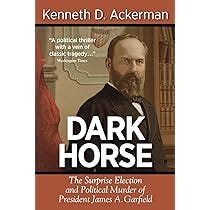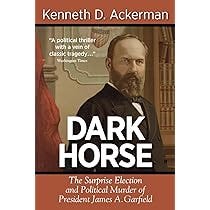The Book, the Man, and the Venue — James A. Garfield
Book Review — "Dark Horse: the Surprise Election and Political Murder of President James A. Garfield" by Kenneth D. Ackerman
Welcome back to “The Book, the Man and the Venue”, my weekly newsletter that aims to shed light on every U.S. president in a way that is engaging, informative, and hopefully, fun!
Every Monday, I’ll be releasing a new article in which I chronicle my journey through one biography for each U.S. President. Each post will consist of three parts: I’ll offer a brief review of the biography (the Book), share reflections on the president’s character and legacy (the Man), and choose a location where I would spend time with the president if they were alive today (the Venue).
Hopefully, you will find the content both enriching and enjoyable, and if you like what you read, please consider checking out my other articles (and subscribing if you don’t already)!
Without further ado: James A. Garfield
The Book
Based on its title alone, it came as no surprise that “Dark Horse: the Surprise Election and Political Murder of President James A. Garfield” would be one of the more action-packed books in my collection. What was shocking, however, was the quality and analysis interspersed within the pages of Kenneth Ackerman’s thriller. Despite being a relatively heavy lift at 453 pages of text, Ackerman’s story is a delight. Not only does it have the drama and suspense of a John Grisham novel, but it tells the story of Gilded Age politics in such a thoughtful manner that it makes the reader question why it has receded from the memory of American historians.
“Dark Horse”, surprisingly the second most popular take on Garfield behind Candace Millard’s “Destiny of the Republic”, is, as Stephen Floyd puts it, “far less a biography than it is a political thriller.” The book provides limited detail about Garfield’s early life and Civil War service, instead focusing exclusively on the period between the 1880 Republican National Convention and Garfield's death in 1881.
Indeed, Garfield isn’t really even the book's primary focus. The story follows four other characters almost evenly (Chester Arthur, Roscoe Conkling, James Blaine, and Charles Guiteau), and while Garfield plays an integral role in the story’s events, it is less of a biography and more a thematic exploration of patronage, ego, and the all the calamities which accompany them.
Nonetheless, the book is a page-turner. Ackerman does an excellent job of adding context and intrigue into the plot, and his chronology of the days leading up to the assassination attempt are simply outstanding. Ackerman has a knack for putting the reader in the perspective of his characters, and his characterization and analysis of Guiteau is probably the book’s highlight.
Obviously, for readers seeking a traditional biography of James Garfield, this book is not the ideal choice. But much like Doris Kearns Goodwin’s "Team of Rivals," "Dark Horse" is about so much more than just a president’s life. It serves as an excellent introduction to the 1880s for casual readers, or even as a second book to more serious historians focused on the life and times of James A. Garfield.
Rating: 7.4/10
The Man
There are many obvious parallels between James Garfield and Abraham Lincoln: both men were born in log cabins on the American frontier—Garfield in Ohio and Lincoln in Kentucky—and experienced poverty in their early years. Both men were incredibly hard workers who used education as a means to better their livelihood. Both men were tall and witty, yet endured the profound loss of children at a young age and ultimately met a tragic fate at the hands of assassins with inflated senses of self-importance.
And yet, a lesser-discussed but equally intriguing similarity between the two leaders was their keen ability to pick political battles. While Lincoln’s examples go without saying, Garfield, too, was an adept political operator. Take his decision to confront Roscoe Conkling — a man who deserves his own post — over the nomination of William Robertson for Collector of the Port of New York. Rather than submit to a Senate boss whose demands would weaken his presidency, Garfield chose to assert his authority, forcing Conkling's hand, and eventually prompting his resignation. Garfield even had Lincoln’s presidential mindset:
“Standing in his White House office…embarrassed, indignant, frustrated, but oddly calm, James Garfield seemed to cross a psychological bridge. He’d made a discovery about his new position: As president of a great country, once he’d made a decision, even a close, dubious one, he had to stick with it. People respected backbone, and without their respect his authority meant nothing. Garfield could no longer live with Roscoe Conkling’s petulant demands hanging over his presidency. Conkling would not be dealt with nor tolerated. If that meant political war, then he had no choice but to fight it.”
Shades of Andrew Jackson during the nullification crisis – oh what could have been if only Garfield has stayed alive.
Side Note: The story of Charles Guiteau – Garfield’s assassin – is incredibly fascinating. As Ackerman summarizes:
“Of the four assassins of American presidents, John Wilkes Booth (Lincoln, 1865), Leon Czolgosz (McKinley, 1901), Lee Harvey Oswald (Kennedy, 1963), and Guiteau, history usually gives Guiteau the least regard, dismissing him as a madman and “disappointed office seeker”—much as the 1881 Stalwarts would have liked. In some ways, though, insane or not, Guiteau was the most successful. Unlike the others, he not only killed a president but deliberately installed a perceived friend, Arthur, in his place. And by his crime he brought about one of the most important reforms of the era: the 1883 Civil Service Act which, in little over a decade, had placed some 86,000 federal positions under a merit system administered by an independent new Civil Service Commission. Today, the vast majority of federal employees have professional civil service status rather than owing their jobs to politicians, a bedrock concept of modern governments around the world.”
Also, while Guiteau’s last words aren’t exactly coherent, there is something still haunting about them:
“I am going to the Lordy; I am so glad,
I am going to the Lordy, I am so glad,
I am going to the Lordy,
Glory hallelujah! Glory hallelujah!
I am going to the Lordy!
I love the Lordy with all my soul,
Glory Hallelujah!
And that is the reason I am going to the Lord,
Glory hallelujah! Glory hallelujah!
I am going to the Lord.
I saved my party and my land,
Glory hallelujah!
But they have murdered me for it,
And that is the reason I am going to the Lordy,
Glory hallelujah! Glory hallelujah!
I am going to the Lordy!
I wonder what I will see when I get to the Lordy,
I expect to see most glorious things,
Beyond all earthly conception,
When I am with the Lordy!
Glory hallelujah! Glory hallelujah!
I am with the Lord.”
Supposedly, the poem was supposed to be read as if it portrayed “a child babbling to his mama and his papa,” but still, what an odd way to go out.
The Venue
Garfield was a big baseball fan, and would occasionally sneak away from Congress to catch a Washington Nationals game whenever he could get the chance. As a Tigers fan myself, I’ve got absolutely no complaints with his choice of pastime. The only questions I have are: what team would he root for and what are his thoughts on the new pitch clock?
I hope that you’ve enjoyed this installment of “The Book, the Man, and the Venue.” If you have feedback about today’s issue, or thoughts about future topics, please feel free to send me a message.
And if you liked it, please consider sharing (and subscribing if you don’t already)!





Naming the four presidents who got assassinated would have been a great trivia question last weekend!